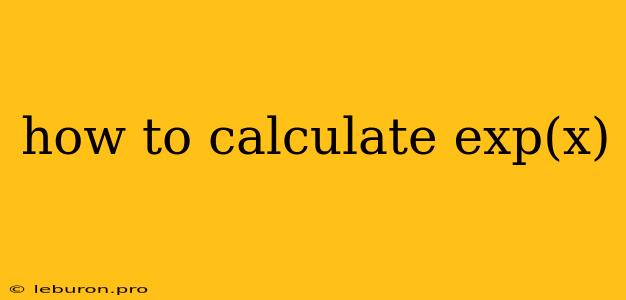The exponential function, denoted as e raised to the power of x, or exp(x), is a fundamental concept in mathematics and finds extensive applications across various fields. It represents the growth of a quantity at a rate proportional to its current value. Calculating exp(x) precisely can be challenging, especially for large values of x. However, several methods exist to approximate the value of exp(x), each offering varying levels of accuracy and computational efficiency. This article delves into different techniques for calculating exp(x), exploring their underlying principles and providing practical examples to illustrate their application.
Understanding the Exponential Function
The exponential function, exp(x), is defined as the limit of (1 + x/n)^n as n approaches infinity. This definition establishes a connection between exponential growth and compound interest. e is a mathematical constant approximately equal to 2.71828. The function exp(x) is closely related to the natural logarithm, ln(x), which is its inverse.
Methods for Calculating exp(x)
1. Taylor Series Expansion
One of the most widely used methods for approximating exp(x) is the Taylor series expansion. This method expresses exp(x) as an infinite sum of terms:
exp(x) = 1 + x + x^2/2! + x^3/3! + x^4/4! + ...
where n! represents the factorial of n. The more terms you include in the series, the more accurate the approximation becomes. However, calculating factorials for large values of n can be computationally expensive.
Example:
To approximate exp(1), we can use the first five terms of the Taylor series:
exp(1) ≈ 1 + 1 + 1/2 + 1/6 + 1/24 ≈ 2.70833
2. Using the Identity exp(x) = (exp(x/2))^2
This method leverages the property that exp(x) is equal to the square of exp(x/2). By repeatedly dividing the exponent by 2 and squaring the result, we can recursively approximate exp(x). This method is particularly efficient when x is large, as it avoids calculating large factorials.
Example:
To approximate exp(4), we can use the following steps:
- exp(4) = (exp(2))^2
- exp(2) = (exp(1))^2
- exp(1) ≈ 2.71828 (using the Taylor series approximation)
Substituting back, we get:
exp(4) ≈ (2.71828)^2 ≈ 7.38905
3. Using the Identity exp(x + y) = exp(x) * exp(y)
This method exploits the property that the exponential of a sum is equal to the product of the exponentials. It allows you to break down exp(x) into simpler terms. For example, exp(x) can be expressed as exp(x/2) * exp(x/2), which can then be further broken down. This approach can be combined with the Taylor series or other methods to calculate exp(x) more efficiently.
Example:
To approximate exp(3), we can use the following steps:
- exp(3) = exp(1 + 2)
- exp(3) = exp(1) * exp(2)
- exp(2) = (exp(1))^2
Substituting back, we get:
exp(3) ≈ 2.71828 * (2.71828)^2 ≈ 20.0855
4. Built-in Functions
Most programming languages and mathematical software packages provide built-in functions for calculating exp(x). These functions are typically implemented using highly optimized algorithms that deliver high accuracy and speed.
Example:
In Python, the math.exp() function can be used to calculate exp(x):
import math
x = 2
result = math.exp(x)
print(result) # Output: 7.38905609893065
Conclusion
Calculating exp(x) precisely requires careful consideration of the desired accuracy, the size of x, and the available computational resources. Taylor series expansion provides a general approach but can become computationally expensive for large values of x. Leveraging the identities exp(x) = (exp(x/2))^2 and exp(x + y) = exp(x) * exp(y) can enhance efficiency, especially for large x. For practical applications, built-in functions offer the most convenient and accurate solutions. Understanding the various methods for calculating exp(x) empowers you to choose the most appropriate technique based on specific requirements.
